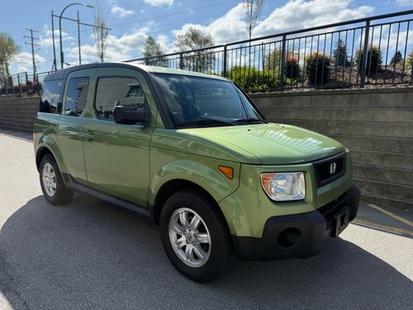The Honda Element is a compact crossover SUV that was produced by Honda from 2003 to 2011. Known for its boxy shape and utilitarian design, the Element carved out a niche market for those seeking a versatile and practical vehicle. Its appeal lies in its spacious interior, flexible cargo space, and rugged appearance, making it popular among outdoor enthusiasts and urban dwellers alike.
History and Background
The Honda Element was introduced as a concept vehicle called the Model X in 2001, showcasing a vehicle designed for active lifestyles. Honda aimed to create a car that combined the practicality of an SUV with the maneuverability of a compact vehicle. The Element officially went into production for the 2003 model year, quickly gaining a reputation for its unique styling and functionality.
The Element's production run saw it undergo several updates, including minor design tweaks and the introduction of additional trim levels to appeal to a broader audience. Despite its popularity, production ceased in 2011 due to declining sales, as consumer preferences shifted towards more conventional SUVs and crossovers.
Key Dates:
- 2001: Model X concept unveiled
- 2003: Honda Element launched
- 2007: Mid-cycle refresh with updated styling
- 2009: Introduction of the SC trim
- 2011: Production ended

2006 Honda Element
$16,800
111,225 miles
Performance and Handling
| Variant | Engine | Power | 0-60 | Top Speed | Fuel Economy |
|---|---|---|---|---|---|
| LX | 2.4L I4 | 160 hp | 8.3 sec | 110 mph | 20/25/22 mpg |
| EX | 2.4L I4 | 160 hp | 8.5 sec | 110 mph | 20/25/22 mpg |
| SC | 2.4L I4 | 166 hp | 8.6 sec | 110 mph | 19/24/21 mpg |
Interior and Comfort
| Feature | Base | Mid | Top |
|---|---|---|---|
| Air Conditioning | ✓ | ✓ | ✓ |
| Cruise Control | - | ✓ | ✓ |
| Premium Audio | - | ✓ | ✓ |
| Sunroof | - | ✓ | ✓ |
| Navigation System | - | - | ✓ |
Technology and Features
Technology by Model Year:
- 2003: Basic CD player, air conditioning
- 2007: Introduction of auxiliary input, improved audio system
- 2009: Optional navigation system, satellite radio capability
Infotainment System:
- Screen size: 6.5-inch (optional in later models)
- Features: CD player, auxiliary input, optional navigation
- Connectivity: Auxiliary input, USB (later models)
Driver Assistance Features:
- Standard: Anti-lock braking system, traction control
- Optional: None
Safety
The Honda Element performed well in safety tests, thanks to its robust structure and array of standard safety features. It was equipped with dual-stage, dual-threshold front airbags, side airbags with passenger-side Occupant Position Detection System (OPDS), and side curtain airbags with rollover sensors.
Safety Ratings:
- NHTSA Rating: 5 stars
- IIHS Rating: Good
Safety Features:
- Standard: Anti-lock braking system, Vehicle Stability Assist, side curtain airbags
- Optional: None
Value for Money
| Year | Condition | Price Range |
|---|---|---|
| 2010 | Excellent | $8,500-$11,000 |
| 2008 | Good | $6,000-$8,500 |
| 2006 | Fair | $4,000-$6,000 |
Running Costs:
Running costs for the Honda Element were generally low, with maintenance and repair costs being relatively affordable. Its fuel economy was average for its class, but its reliability helped keep long-term costs in check.
- Fuel Economy: 20/25/22 mpg (city/highway/combined)
- Service Intervals:
- Oil Change: Every 5,000 miles
- Major Service: Every 30,000 miles
- Common Repair Costs:
- Brake Pad Replacement: $150-$300
- Alternator Replacement: $400-$600
Known Issues by Year:
- 2003: Door lock actuator failures
- 2007: Paint quality issues
Competitor Comparison
Competitor 1: Toyota RAV4
- Market Position: The Toyota RAV4 is a well-established compact SUV known for its reliability and practicality.
- Features Comparison: Offers more conventional styling and additional engine choices.
- Price Comparison: Slightly more expensive than the Element, but offers more modern amenities.
- Running Costs: Similar fuel economy, but slightly higher maintenance costs.
Competitor 2: Ford Escape
- Market Position: The Ford Escape is a popular choice among compact SUV buyers looking for a blend of performance and utility.
- Features Comparison: Offers more powertrain options and a more refined interior.
- Price Comparison: Comparable pricing, with more frequent discounts and promotions.
- Running Costs: Higher fuel consumption, but generally lower repair costs.
Competitor 3: Subaru Forester
- Market Position: Known for its standard all-wheel drive and rugged capability, appealing to outdoor enthusiasts.
- Features Comparison: Offers better off-road capabilities and more advanced safety features.
- Price Comparison: Generally more expensive, with higher resale value.
- Running Costs: Similar fuel economy, with higher insurance premiums.
Verdict
The Honda Element is a unique offering in the compact SUV market, with its boxy design and versatile interior catering to a specific segment of buyers. While it may lack the refinement and technological advancements of some of its competitors, it compensates with practicality, reliability, and a distinctive character. For those who prioritize functionality and flexibility, the Element is a compelling choice.